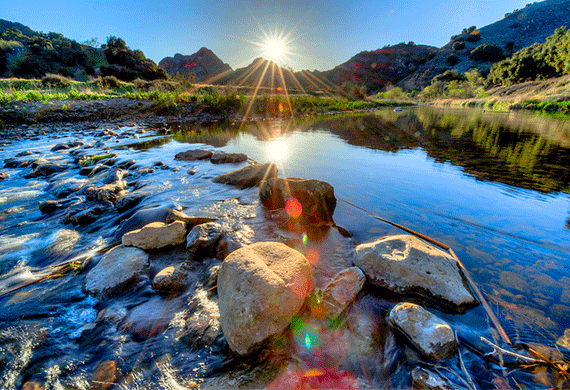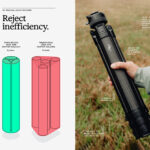Lenses are one of the most important considerations in photography. The lens you choose for each shot can dramatically change your results; its best to know how all the types work so you can make more informed decisions as a photographer in various situations.
Wide Angle Lenses
Wide angle lenses, are identified by the bulbous shape to the glass front of the lens. They are loved by landscape photographers the world over. A good lens should include high quality glass, have a low corner distortion rate, where a falloff in sharpness in the corners is minimal, and versatile features such as Image Stabilization (IS). Ideally they should also include a lens hood to minimize lens flare, when shooting into light or the sun. Generally the heavier a wide angle lens the higher quality of the glass used in manufacture, and the better the lens overall.

Photo by 45SURF Hero’s Odyssey Mythology Photography; ISO 100, f/22.0, 1/40-second exposure.
Fisheye Lenses
Fisheye lenses are amazing bits of glass. With the bulbous element protruding from the housing of the lens, they are quite fragile and easy to scratch. They can’t be protected by a UV filter; instead, use slip in gelatin filters in the rear of the lens. Find one thats fast–f/2.8 or f/3.5–like Sigma’s 8mm. Look for edge to edge sharpness, as well. Again, price will dictate quality. These are great for fitting the whole world into one shot–almost literally–with most providing a full 180 degree view! Expect to pay between $1K and upwards of $3K for top end fisheye lenses.

Photo by Jamie Dobson; ISO 250, f/20.0, 1/4-second exposure.
Telephoto Lenses
Telephoto lenses are probably the most popular of all lenses. They are perfect for portrait and wildlife photography, as they offer a closer view to your subject, and in doing so, keep distortion low. Faster lenses with some type of stabilization are best. Look for stats such as f/2.8 or similar with IS or OS.

Photo by Rodney Campbell; ISO 250, f/9.0, 1/400-second exposure.
Macro Lenses
Macro lenses, often used for focussing on finite detail in very small objects, are usually high quality lenses that are well manufactured. Find a lens with a fast maximum aperture of f/2.0 or f/2.8, if possible. You’ll pay more, but your ability to experiment with selective focus will be much greater.

Photo by Desirae; ISO 400, f/10.0, 1/200-second exposure.
Tilt Shift Lenses
Tilt Shift lenses are high end and ideal for correcting camera perspective caused by angling upwards or downwards, which results in a “leaning in or leaning out” type distortion. The frontal lens element is shifted to oppose the tilt of the camera. Usually not wider than 90mm, expect to pay upwards of $2K per unit, but it’s well worth it.
Tilt Shift lenses can also be used to create a miniature effect This effect mimics the extremely limited depth of field by fast, shallow depth of field lenses and can be used to incredible effect.

Photo by Ian Carroll; ISO 100, f/1.8, 1/125-second exposure.
Glossary of Lens Technical Terms
Aperture: The front opening of a lens through which light enters.
Aperture f-stops: The unit of measure that controls both of field and the amount of light entering the camera. Settings are f/1, f/1.4, f/2, f/2.8, f/4, f/5.6, f/8, f/11, f/16, f/22, f/32, f/45, f/64.
Back focus: Lens focus error where focus lands behind the intended subject.
Bokeh: Out of focus blur effect that helps separate your subject from background. Often used to create a miniature effect.
Chromatic aberration: The failure of a lens to focus all lightwaves to a single point. Often results in a purple or violet edge along objects in high contrast situations.
Constant aperture: Zoom lenses that have the same maximum aperture at all focal lengths.
Crop factor: Created by the use of sensors smaller than 35mm film where only the center of the image is captured. Example: a 100mm lens on a 1.5x crop camera will have a field of view equivalent to 150mm.
Depth of field: The measure of focus where the front edge of focus through to the back edge or final focus point lands.
Deep: Little/no background blur achieved through small apertures (f/16, 22, etc.) common for shooting landscapes.
Diffraction limit: The point where lenses get soft at extremely small apertures.
Digital specific lenses: Lenses designed specifically for the smaller sensors of digital cameras. Often identified by DC (Digital Cropped) on the lens.
F-stop: Refers to aperture and ISO adjustments that halve or double the required time of exposure.
Fast: A general term used for a large aperture lens, fast lenses are ideal for shooting quick action. Often f/2.8 or f/2.
Focal length: The physical length, in millimeters, a lens requires to bring the light to a focus point. Identified in mm on the lens, such as 18-200mm.
Focal ratio: The relationship between aperture and lens focal length. It is found by dividing the focal length by the aperture. Commonly referred to as the “f-number”. Example: f/2.8.
Front focus: Lens focus error where focus lands in front of the intended subject.
Full frame lenses: Lenses suited to cameras with full frame sensor (the same size as 35mm film). Often identified by DG on the lens.
Full time manual focus: Seen in sonic motor lenses, the ability that allows the photographer to manually focus the lens while still having the lens in autofocus mode.
Image stabilization: Compensates for camera shake commonly seen with slow shutter speeds, it can be either lens or camera body based and is ideal for stationary subjects.
ISO speeds: Controls the sensitivity of your camera and its ability to see in the dark. the higher the number, the more sensitive to light, therefore the more your camera can see in the dark. Speeds are 100, 200, 400, 800, 1600, 3200, 6400, 12,800, 25,600.
Micro focus adjust: A recent innovation that allows the photographer to fine tune focusing of the camera to compensate for a front or back focusing lens.
Micro-motor: A tiny motor inside utilizing gears inside a lens used for autofocus purposes that is not capable of full time manual focus.
Motion blur: Seen at slow shutter speeds, blur caused by the motion of photographic subjects.
Prime lens: A fixed focal length lens.

Photo by Cohen Van der Velde; ISO 100, f/9.0, 1/800-second exposure.
Shallow: Much background blur achieved through large apertures (F4, 5.6 etc), common in portraits.
Sharp: The term for a lens that produces extremely clear pictures with much fine detail.
Slow: A general term for small aperture lenses Often F4.5-F5.6 of F5.6-F8.
Soft: Refers to a lens where images look slightly blurry because of optical issues. All but the highest quality lenses tend to be a little soft at maximum aperture.
Stopping down: The term for closing down the aperture of a lens.
Telephoto: Long photographic lenses used for capturing distant subjects.
Ultra Sonic Motor: Autofocus motors characterized by fast, silent operation that is also capable of full time manual focus.
Variable aperture: A lens where maximum aperture changes throughout the focal length, always getting slower at longer focal lengths.
Wide open: The term for a lens being used at maximum aperture.
Zoom lens: A lens with a varying focal length.
Zoom ratio: The relationship between a zoom lens’s minimum and maximum focal length. Most pro-grade lenses have a 4x ratio or less. Example: a 12-24mm lens has a 2x zoom ratio.
About the Author:
Steve Rutherford (photographicfanatic dot com) is a photographer with a publication based in Australia.
Like This Article?
Don't Miss The Next One!
Join over 100,000 photographers of all experience levels who receive our free photography tips and articles to stay current:






In that case, I will choose telephoto lens. Thank you for this detailed information.
which of the lenses is best used for a wedding ceremony and how can i get a cheap camera and at how much